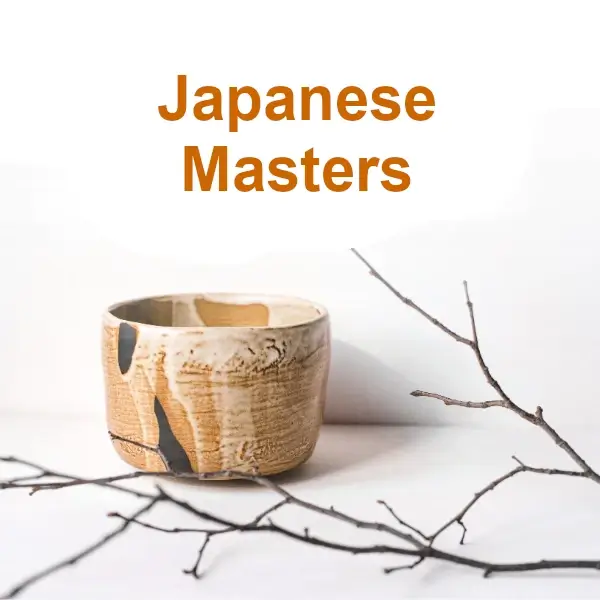Hagi ware: Japan’s clay jewelry
Hagi ware originates from the city of the same name in Yamaguchi Prefecture, Japan, and is highly valued for its distinctive simplicity and the subtle beauty of its tea ware.
It is also especially well known for the “kannyu” cracks that develop with use, transforming each piece in a unique way over time.
Tracing its roots back to the end of the 16th century, this pottery tradition was enriched by Korean craftsmen who traveled to Japan, giving Hagi yaki pieces their deep aesthetic and cultural essence.
The charm of Hagi ceramics lies in its understated elegance and the warm serenity it brings to the tea experience, inviting a deeper exploration of its rich heritage and artistic nuances.

History and Origin of Hagi Ceramics
This type of pottery, one of the most emblematic traditions of Japanese pottery, has its roots in the picturesque town of Hagi, located in Yamaguchi Prefecture.
This ceramic art dates back approximately 400 years, coinciding with the time when the Edo bakufu was established in 1604.
The introduction of Hagi ware is attributed to the arrival of Korean craftsmen in Japan, who were brought by the feudal lord Terumoto Mori after the Battle of Sekigahara in 1600, marking the beginning of this rich tradition.
Its development was not only limited to the production of utensils for the tea ceremony, such as chawan bowls, but also extended to the creation of various items for everyday use, especially after the rule of the feudal lords was privatized during the Meiji period.
This transition to the production of everyday items, including bowls and cups for various uses, allowed this pottery to become even more integrated into everyday life in Japan.
The uniqueness of Hagi pottery lies not only in its history and origin, but also in its unique characteristics and production methods, which will be explored later in this article.
Unique Characteristics of Hagi Ceramics
Hagi ware, originating from Yamaguchi Prefecture in Japan, is recognized for its simple aesthetic and unique texture that comes from the local clay known as Kuchi-tsuchi. This clay gives it an earthy texture and smooth finish that naturally conforms to the touch, inviting a distinct sensory experience.
A distinctive feature of Hagi pottery is the pattern of fine cracks known as “kannyu”, which forms on the surface during the firing process due to different rates of shrinkage between the glaze and the clay.
This effect not only adds a visual dimension to the piece, but also allows the ceramic to change color over time as liquids such as tea or sake penetrate these cracks, enriching its appearance and making each piece transform and become unique with use.

In addition, this type of handicraft is characterized by its varied palette of subtle and natural colors, from earth tones to pure whites, achieved through different types of glazes such as biwayu and Hagi white glaze. These glazes not only enhance the texture of the clay, but also contribute to the rich artistic expression of each piece.
Hagi Ceramic Production Techniques and Processes
The production of Hagi ware is an art that has been perfected over centuries, integrating traditional techniques passed down from generation to generation. This pottery, known for its smooth texture and colors that evoke nature, originates in Yamaguchi Prefecture, where the use of three different types of clay gives each piece its unique character.
The mud from Mishima Island, Mitake Mountain and Daido are fundamental in this process, each providing specific properties that influence the final result of the work.
The process of creating a piece of Hagi pottery involves several carefully executed steps. Initially, the clay is mixed and kneaded to the desired consistency.
The piece is then molded and shaped, a process that requires great skill and artistic sensitivity. Once formed, the piece undergoes an initial firing, followed by the application of specific glazes that contribute to its characteristic aesthetics.
Biwayu glaze, for example, is known for its orange color similar to that of biwa fruit, while Hagi white glaze, possibly of Korean or Chinese origin, gives a white, textured finish to the piece.
The final firing is crucial for the development of the fine cracks known as “kannyu”, which are distinctive to Hagi ware. These cracks form due to the difference in shrinkage rates between the glaze and the clay during cooling.
Over time and with use, beverages such as tea penetrate these cracks, subtly modifying the color of the pottery and enriching its beauty. This process of continuous transformation gives each piece of Hagi ware its own history and personality, a characteristic that makes it deeply appreciated both in the tea ceremony and in everyday life.
The best works in Japanese ceramics



